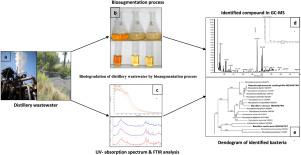Environmental Technology & Innovation ( IF 7.1 ) Pub Date : 2021-07-07 , DOI: 10.1016/j.eti.2021.101774 Sonam Tripathi 1 , Pooja Sharma 1 , Diane Purchase 2 , Madhu Tiwari 3 , Debasis Chakrabarty 3 , Ram Chandra 1

|
The objective of this work was to study the potential of a constructed bacterial consortium (comprising strains of Stenotrophomonas maltophilia, Bacillus cereus, and Bacillus anthracis) to treat distillery wastewater via the bioaugmentation process. The discharged wastewater showed elevated total ammonium nitrogen(195.0 ± 1.24 mg L−1), total dissolved solids (25980.6 8.09 mg L−1), chemical oxygen demand(20534.5 3.12 mg L−1), and biological oxygen demand (20534.5 3.12 mg L−1). High concentration of heavy metals phenolic and organo-metallic compounds were also detected. Results showed that growing the bacterial consortium in the distillery wastewater at 37 °C supplemented with 1% glucose achieved the best colour reduction (up to 90%) in 144h. The physico-chemical quality of the treated wastewater also improved by 50%–70%. Furthermore, many of the major organic pollutants present in the distillery wastewater were degraded by the constructed consortium to below detection limit via active biotransformation and biodegradation Heavy metals were biosorbed by the bacterial consortium, and the ligninolytic enzymes such as Lip and MnP played an important role in the degradation of the organo-metallic pollutants. The constructed bacterial consortia therefore offered a sustainable and effective solution to treat distillery wastewater.
中文翻译:

采用生物强化工艺生物降解酒厂废水中的有机金属污染物
这项工作的目的是研究构建的细菌聚生体(包括嗜麦芽窄食单胞菌、蜡状芽孢杆菌和炭疽芽孢杆菌的菌株)通过生物强化过程处理酿酒废水的潜力。排放的废水显示总铵态氮(195.0 ± 1.24 mg L -1)、总溶解固体(25980.68.09 mg L -1 ),化学需氧量(20534.53.12 mg L -1 ) 和生物需氧量 (20534.53.12 毫克升-1)。还检测到高浓度的重金属酚类和有机金属化合物。结果表明,在 37 °C 的蒸馏废水中生长细菌聚生体并补充 1% 葡萄糖在 144 小时内实现了最佳的颜色减少(高达 90%)。处理后废水的理化质量也提高了 50%–70%。此外,酿酒废水中存在的许多主要有机污染物被构建的聚生体通过主动生物转化和生物降解降解至检测限以下重金属被细菌聚生体生物吸附,Lip和MnP等木质素分解酶发挥了重要作用降解有机金属污染物。



























 京公网安备 11010802027423号
京公网安备 11010802027423号